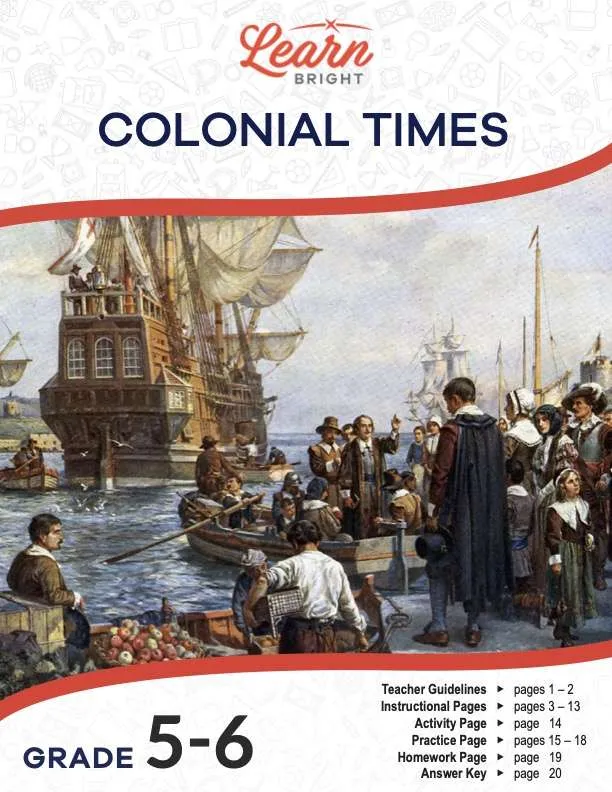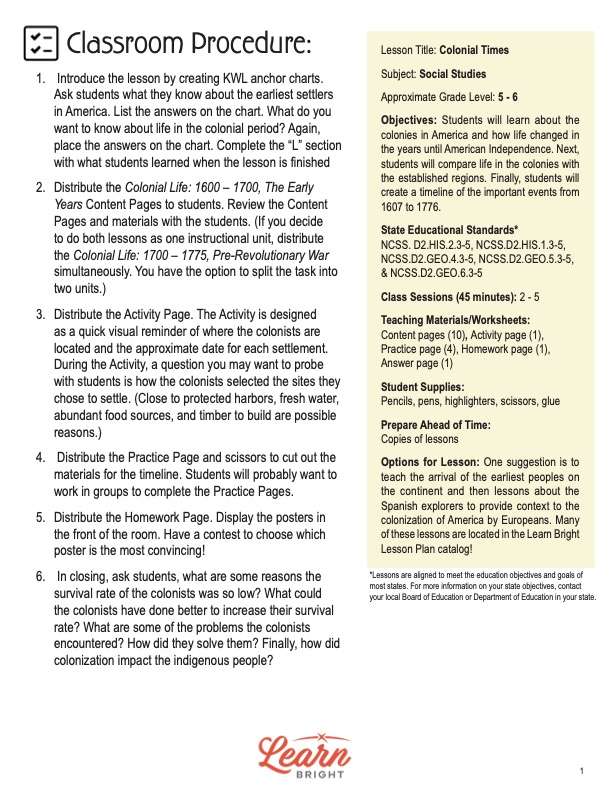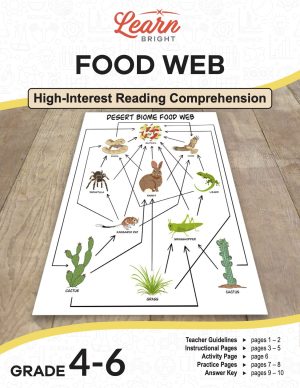Description
What our Colonial Times lesson plan includes
Lesson Objectives and Overview: Colonial Times introduces students to what life was like during Colonial Times in America. This interactive lesson engages the imagination and knowledge of students on what it was like being a child during the era. At the end of the lesson, students will be able to identify and describe living conditions during Colonial Times in America. This lesson is for students in 4th grade, 5th grade, and 6th grade.
Classroom Procedure
Every lesson plan provides you with a classroom procedure page that outlines a step-by-step guide to follow. You do not have to follow the guide exactly. The guide helps you organize the lesson and details when to hand out worksheets. It also lists information in the orange box that you might find useful. You will find the lesson objectives, state standards, and number of class sessions the lesson should take to complete in this area. In addition, it describes the supplies you will need as well as what and how you need to prepare beforehand. For this lesson, you will need writing utensils, scissors, and glue.
Options for Lesson
Included with the Colonial Times lesson plan is an “Options for Lesson” section that lists a number of suggestions for activities to add to the lesson or substitutions for the ones already in the lesson. One suggestion is to teach about the arrival of the earliest peoples on the continent. Then you can teach lessons about the Spanish explorers to provide context to the colonization of America by Europeans. You will find many of these lessons in the Learn Bright lesson plan catalog.
Teacher Notes
The teacher notes page includes a paragraph with additional guidelines and things to think about as you begin to plan your lesson. It notes that the Colonial Times lesson plan divides into two sections that cover the period of earliest colonization and the pre–Revolutionary War days. You can teach the two sections simultaneously as one instructional unit or separately. This page also includes lines that you can use to add your own notes as you prepare for this lesson.
COLONIAL TIMES LESSON PLAN 1600–1700—THE EARLY YEARS CONTENT PAGES
Nomads
The Colonial Times lesson plan “Early Years” section contains six pages of content. The question of who settled America first and when is essential. Many historians think the earliest settlers in America migrated from Asia more than 20,000 years ago. These ancient hunter-gatherers were nomads, people who migrated continually in search of food and better climates.
Unfortunately, we don’t know much about them other than that they traveled great distances. We also know it would take thousands of years before they settled and formed tribes. Much later in the 10th century, Vikings explored the northernmost coast of America. Some historians believe they established colonies but were unable to sustain them. In the opposite direction, the Spanish and others sailed to what is now Florida and into the Gulf of Mexico.
Colonization of the Americas
Between 1500 and 1800, explorations by France, Portugal, Netherlands, and other European countries made several attempts to explore the New World. Like the Spanish, new settlements were mainly small military posts or short-term ports of entry instead of long-term colonies. Eventually, the Spanish, French, Dutch, Portuguese, and others saw the advantage of colonization or of establishing permanent settlements.
For example, in 1565, Spain settled in Saint Augustine, Florida, establishing the earliest known thriving colony in America. The French took advantage of the opportunity to establish colonies along the St. Lawrence River and begin a lucrative fur trade business. And other European countries maintained relatively small outposts in America.
Finally, forty-one years after the Spanish began St. Augustine, the British accelerated the colonization of the Americas. In late December of 1606, a ship carrying 104 English men and boys left England for North America. In mid-May of 1607, the expedition leaders settled on a cove in Virginia after scouring the coast for a suitable landing area. They named the new colony Jamestown after King James I. Historians believe this to be the first permanent English settlement in North America. With the establishment of Jamestown, historians begin the Colonial Period in American history.
The Beginning of Jamestown
Jamestown may not have been the first colony in America. However, historians have unearthed many original artifacts and, as a result, know a lot about life in the settlement. For example, upon landing on what looked like a protected cove, the colonists immediately began constructing a makeshift fort. They also started scouring the nearby forests for food and clean water. Food, water, and housing were always the top priorities of colonists.
The first year at Jamestown was unimaginably challenging. Of the original 105 settlers, only 35 remained by the end of the first year. The settlers weren’t prepared for the rigors of establishing a colony. Disease, famine, and periodic attacks from the Powhatan Indians depleted the workforce and will power of the survivors.
Clean water took much work to find. By the time of the first supply replenishment, the colonists were physically and mentally defeated. But the colony returned viable with new supplies and an influx of new laborers. That would soon change when the relations with the Powhatan tribe, who had supplied food to the settlement, changed for the worse.
The winter became known as the “starving time.” After failing to reach a trade agreement with the Powhatan tribes, the tribes surrounded the fort. Nearly 300 (some records suggest 500) settlers crowded into the small fortress. However, the Powhatan siege prevented food or supplies from getting to the colonists. By the end of the winter, only about 60 settlers remained alive.
Spring and summer ushered in new challenges. Mosquitoes brought disease. Heat and humidity took their toll on the colonists that were not used to working in hot, humid weather. Many of the settlers decided to abandon the fort. Before leaving the fort, another supply ship arrived and replenished the food of the settlers. New leadership were able to negotiate peace with the Powhatans, and for several years, the colony flourished and began to grow.
More Difficulties in Colonial Times
People of Jamestown learned that for a colony to thrive, it needed solid leadership and a resilient population. A military advantage was not always the key to surviving in unfamiliar territory. Good relationships with the native people were critical. The French were particularly adept at collaborating with the native tribes in their colonized areas.
Life in the new colonies was more complicated than many settlers imagined. They faced dangers they did not consider, such as disease and harsh climates. Settlers had to have skills in farming, carpentry, and other trades to carve out a civilization successfully. Regardless, failure did not deter the desire of European countries to settle in the Americas.
By 1611, as Jamestown still floundered, the investors of the Virginia Company became dissatisfied with the direction of colonization in Virginia. The investors expected to become rich but instead were losing money, not getting wealthy. In 1611, colonists began to flood Virginia, convinced they would become rich.
Unfortunately, the Virginia Company learned little from their earlier experiences in Jamestown and relied on inexperienced leaders to manage colonization. Many new colonists needed to gain the skill or knowledge to survive in a wilderness colony. Like the first Jamestown, the colonists had no idea how to grow food, and starvation and disease ravaged the settlements.
Eventually, after much loss of life and money, colonization took hold in Virginia. First, people cultivated much of the land, mostly with tobacco. Then, in 1619, the colonies began using slave labor from Portuguese traders. This was not the first time people in the Americas used slave labor. The slave trade began in the 1500s when the Spanish enslaved native populations after arriving in Florida in 1513. However, this started a bleak time in American history when slave labor became an acceptable labor practice for nearly two and a half centuries.
Things Start Looking Up
Over time, the colonists became immune to many diseases that plagued them early in colonization. New settlers were more aware of what was necessary to survive and were better prepared when they arrived. However, relations with native tribes remained inconsistent. The colonists eventually decided that the best way to interact with native tribes was to remove them forcefully. The threat of force did not help maintain peace. Finally, in 1624, due to mismanagement, the British government replaced the Virginia Company. Virginia became a crown colony, or one that the monarch or king authorized.
Historians tend to focus on Virginia colonies because there are many primary source materials that document them. However, several other efforts to colonize happened simultaneously. Unfortunately, many of these met the same fate as the early Jamestown colonists. People suffered death by disease, famine, poor water sanitation, or from the unpreparedness of the colonist to deal with the harsh life of settling in unfamiliar territory. Nevertheless, many did find a way to survive and prosper.
The next page and a half provides a chart. The chart lists significant events, along with the date and description, for students to reference. It starts with the settlement of present-day Nova Scotia in 1604. The last event explains that the population of the colonies by 1700 equaled approximately 260,000 settlers. That number does not include slaves or Native Americans who lived among the settlers.
Difficult Early Life in Colonial Times
Life for most of the early settlers was incredibly difficult. Nearly everything they owned they had to fashion by hand from the natural resources available. Food was scarce, diseases were rampant, and adapting to seasonal changes took its toll on new settlers. Relationships between the colonists and native populations were always uneasy. Native Americans believed the land and resources belonged to everyone. Protecting the resources was an essential part of their spiritual beliefs.
Colonists had a much different understanding of land and resources. The colonists believed that a person could own as much land as they could farm. Religion played a large part in the daily life of many colonists. The colonists used their religious beliefs to claim authority over the native peoples and justify land ownership as a moral right.
The early colonists were beset with bad decision-making, poor preparation, and a lack of understanding of how to survive in unexplored territory. However, the colonies began to grow eventually. The first settlers paved the way for more colonists. The second and third generations of colonists still had to endure some of the same rigors as the first generation. But they knew what to expect and were better prepared. As a result, by the 1700s, life in the colonies was very different than it was in the early 1600s.
COLONIAL TIMES LESSON PLAN 1700–1775—PRE-REVOLUTIONARY WAR CONTENT PAGES
Thriving Colonies in Colonial Times
The Colonial Times lesson plan “Pre-Revolutionary War” section contains five pages of content. By the 1700s, life in the colonies was dramatically different from that of the early years. The Americas remained agriculturally oriented, but several large cities were on the eastern coast. Muddy roads and trails connected the towns. Ships sailed in and out of the harbors of New York, Boston, and Charleston.
The populations of both Boston and Philadelphia exceeded 12,000. By today’s standards where cities house more than a million people, that doesn’t seem like very many folks! But in the 1700s, Boston, Philadelphia, and New York combined equaled more than 12% of the total population in the Americas (not including enslaved people or native indigenous tribes).
There was a significant disparity between life in an urban city and its rural neighbors. All the colonies depended on agriculture. However, in the cities,
there was more opportunity for employment outside of farming. For example, construction jobs were plentiful. The need for shipbuilders was constant, and industries supporting the ports likewise searched for workers constantly. Shops and taverns intermixed with residences. Many urban residents were wealthy, and their homes mimicked rich European designs.
The vast majority of American colonists had European roots and relatives in Europe. Trade between the two countries was booming as the Americas supplied the raw materials to make finished goods in European factories. Then the Europeans would export the finished products—like furniture, clothing, and other goods—back to the American colonists.
Food and Growing Tensions
The middle and southern colonies specialized in growing tobacco, rice, indigo, and cotton. These were all valuable commodities to trade with Europe. By the 1770s, tobacco represented 27% of the exports and wheat 19%. And while cash crops like tobacco, rice, and indigo created wealth among the large landowners, the crops had a negative side.
The expansion of agriculture required lots of labor, and the slave trade began to fill the demand for farm laborers. Though often thought of as just a southern colony need, historically, every colony benefited in some way from slave labor. For example, some of the most extensive slave auctions occurred in New York. The upper-middle and northern colonies sold fish, lumber, grains, and metals. The ports of New York, Boston, Philadelphia, Charleston, and Savannah were busy hubs of activity.
By the mid-1700s, the colonists began thinking of themselves differently from the first settlers in the 1600s. Second and third-generation American colonists did not have the same allegiance or dependence on the European governments of France, Spain, and Great Britain. Though trade with Europe was vibrant and connected Europe with America, wars between France and Great Britain started to spill onto American soil.
France and Great Britain
At first glance, one might think a war in Europe and the problems of Europe wouldn’t impact the Americas. After all, America was an ocean away from Europe. However, beginning around 1754, the French and Indian War (also known as the Seven Year’s War) pitted the mostly British-allied American colonists against the French on American soil. Caught in the middle were the indigenous Native American tribes, unable to remain neutral and forced to choose a side.
The tribes fought to maintain control over the land they lived and hunted on for generations before colonization. And the colonists’ growing expansion west threatened their cultural heritage and freedom. However, the French and British cared solely about land and continuing to extract natural resources or wealth to return to their countries. In addition, both countries attempted to ally with local native populations to control the Ohio River Valley area to facilitate trade.
However, the French had better relationships with the indigenous peoples. French fur traders respected the boundaries of the local tribes and maintained close ties with them. The British believed the local tribes to be culturally inferior to Europeans. They reneged on nearly every agreement they made with local tribes. Eventually, the war ended with a British victory, primarily due to their numerical advantage in soldiers and their control of the ports on the eastern coast.
Native tribes that aligned with the British celebrated the win. Unfortunately, it was short-lived as the British once again refused to honor the agreements they had made with the tribes as an incentive to fight the French. As a result of the turmoil, many colonists began questioning why having foreigners on American soil was a good idea. Although many American colonists thought of themselves as British citizens, the British thought them to be more like employees than citizens with rights.
Taxes
It would not be long before the British, strapped for cash from the wars in Europe and paying for colonization, began to raise fees and taxes on the American colonists. However, in fairness to the British, they had protected the colonies with a large military. In addition, they provided several other services to the American colonists from the first day the British arrived some 150 years earlier. Asking for repayment of benefits did not seem out of line to the British Parliament. Between 1760 and 1775, the British began passing a series of taxes and fees. Four acts or laws, in particular, angered the colonists—Sugar Act, Stamp Act, Townshend Acts, and Intolerable Acts.
The Stamp Act of 1764, for instance, taxed all printed materials, like newspapers legal documents. Even playing cards needed an official tax stamp. The Intolerable Acts took away rights of self-governance in Massachusetts, which caused further outrage. This led the first Continental Congress to meet in September of 1774 to decide how to respond to the actions of the British government.
Taxes were not the only reason the American colonists began to rethink their relationship with Great Britain. Recall the British Parliament did not provide the same civil rights or liberties to the colonists as other British citizens. In addition, the colonists were not represented in the British Parliament.
Nearing the End of Colonial Times
Between 1700 and 1775, the population of the colonies steadily increased. The emergence of large cities began, and the American colonists began questioning their allegiance to Great Britain. Several important leaders emerged. The colonies started expanding west towards the Ohio River. Regional differences in the colonial economies developed. For example, the north became more industrial while the south became the center for farming.
By the end of 1775, it became evident that the British Parliament and the King of England were not interested in negotiating issues such as governance, trade, and representation in Parliament with the American colonists. As a result, the First Continental Congress debated what to do. Many advocated for more negotiations while others wanted independence. The American colonists, many of whom still had relatives in Great Britain, were also divided. Eventually, tensions between the two continents boiled over, and a war was the result.
By 1775, the population in the colonies was about 2.5 million people. While still primarily an agricultural or farming economy, the colonies had developed several large ports on the eastern coast. In addition, there were several large cities connected by dirt roads. The cities were vibrant, with many shops and taverns that the residents supported. A new class of leaders emerged, who were educated in European history, Latin, mathematics, and general economics.
The colonists pushed westward toward the Ohio River. Religion and religious tolerance flourished. A sense of civic pride took over the colonists, and a belief in American governance free of European interference took shape. By the end of 1775, these forces converged into what we now call the United States of America!
COLONIAL TIMES LESSON PLAN WORKSHEETS
The Colonial Times lesson plan includes three worksheets: an activity worksheet, a practice worksheet, and a homework assignment. You can refer to the guide on the classroom procedure page to determine when to hand out each worksheet.
COLONIAL TIMES ACTIVITY WORKSHEET
For this activity, students will label the names of the 13 colonies on the map. They must also include the date on which the colony started. You can choose whether or not to allow students to reference the content pages for help.
CREATE A TIMELINE PRACTICE WORKSHEET
The practice worksheet requires students to create a timeline of various events. To make it challenging, students will cut out all the squares of information from the three columns: colony and location, date, description of colony. They will place all the pieces in a box and shake the box thoroughly. Then they will match the pieces (three pieces of information per timeline event) and paste them onto the timeline in the correct order. There are also four extra events to add to the timeline that have two pieces each. (Those events are all acts, such as the Townshend Acts.)
PERSUASION POSTER HOMEWORK ASSIGNMENT
Students will create a poster that encourages British citizens to become American citizens. They can use the blank square on the homework page or use a separate sheet of poster or construction paper. They should include artwork, either drawn or pasted, to add creativity to the poster.
Worksheet Answer Keys
The Colonial Times lesson plan includes an “answer key” for the practice and homework worksheets. Neither assignment has right or wrong answers, so this page is meant to be more of a guideline for you. If you choose to administer the lesson pages to your students via PDF, you will need to save a new file that omits this page. Otherwise, you can simply print out the applicable pages and keep this as reference for yourself when grading assignments.










